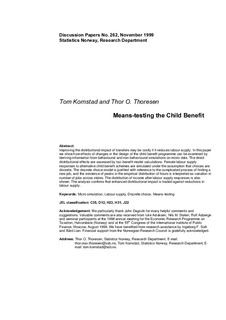Means-testing the child benefit
| dc.contributor.author | Kornstad, Tom | |
| dc.contributor.author | Thoresen, Thor Olav | |
| dc.date.accessioned | 2012-02-02T18:29:33Z | |
| dc.date.available | 2012-02-02T18:29:33Z | |
| dc.date.issued | 1999 | |
| dc.identifier.issn | 1892-753x | |
| dc.identifier.uri | http://hdl.handle.net/11250/180817 | |
| dc.description.abstract | Improving the distributional impact of transfers may be costly if it reduces labour supply. In this paper we show how effects of changes in the design of the child benefit programme can be examined by deriving information from behavioural and non-behavioural simulations on micro data. The direct distributional effects are assessed by taxbenefit model calculations. Female labour supply responses to alternative child benefit schemes are simulated under the assumption that choices are discrete. The discrete choice model is justified with reference to the complicated process of finding a new job, and the existence of peaks in the empirical distribution of hours is interpreted as variation in number of jobs across states. The distribution of income after labour supply responses is also shown. The analysis confirms that enhanced distributional impact is traded against reductions in labour supply. | no_NO |
| dc.language.iso | eng | no_NO |
| dc.publisher | Statistics Norway, Research Department | no_NO |
| dc.relation.ispartofseries | Discussion Papers;No. 262 | |
| dc.subject | Labour supply | no_NO |
| dc.subject | Child benefit | no_NO |
| dc.subject | Micro simulation | no_NO |
| dc.subject | Discrete choice | no_NO |
| dc.subject | JEL classification: C35 | no_NO |
| dc.subject | JEL classification: D12 | no_NO |
| dc.subject | JEL classification: H23 | no_NO |
| dc.subject | JEL classification: H31 | no_NO |
| dc.subject | JEL classification: J22 | no_NO |
| dc.title | Means-testing the child benefit | no_NO |
| dc.type | Working paper | no_NO |
| dc.subject.nsi | VDP::Social science: 200::Economics: 210::Economics: 212 | no_NO |
| dc.source.pagenumber | 24 s. | no_NO |
Tilhørende fil(er)
Denne innførselen finnes i følgende samling(er)
-
Discussion Papers [1002]
